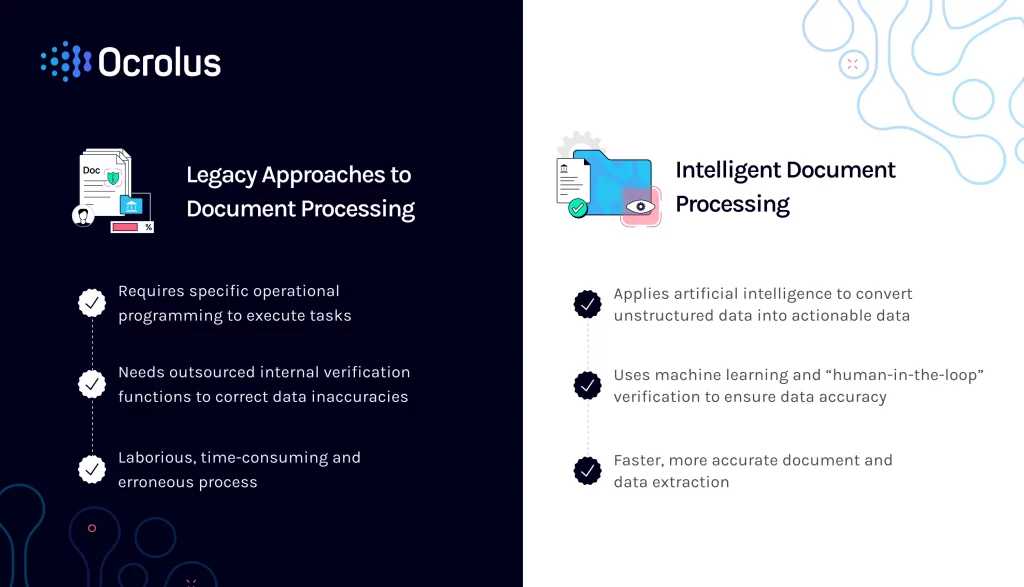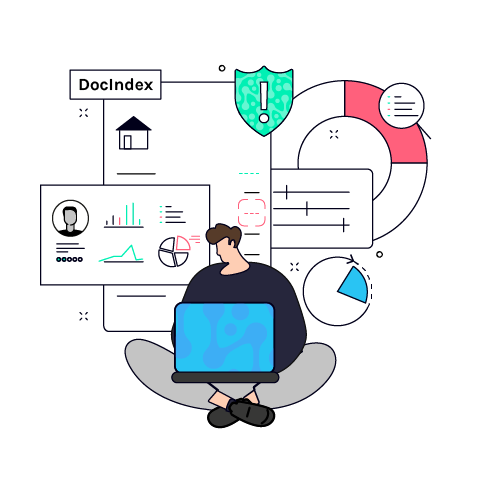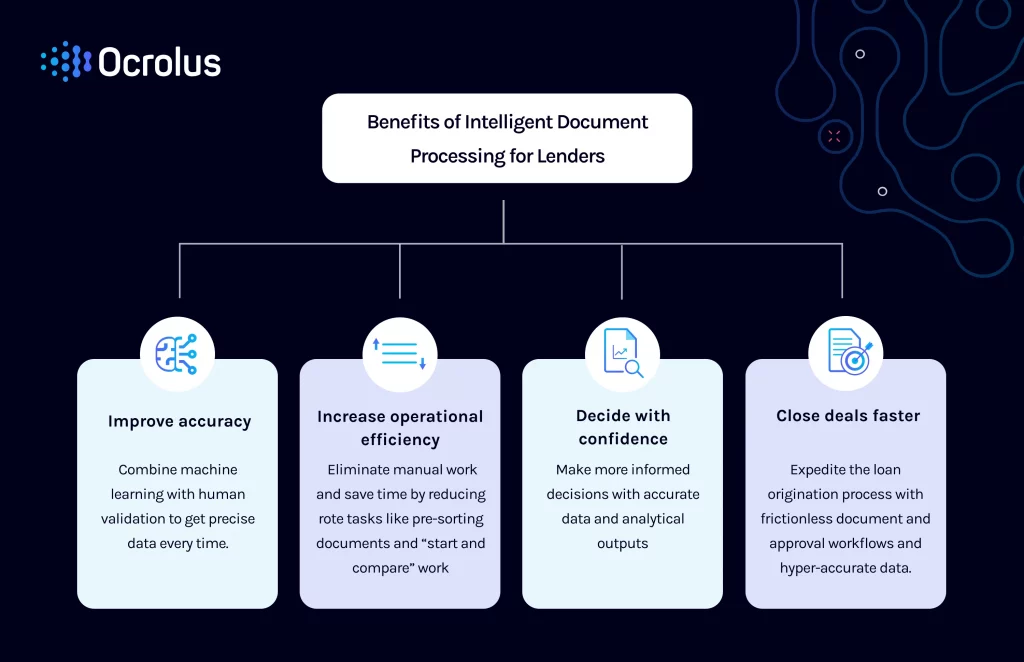This website uses cookies so that we can provide you with the best user experience possible. Cookie information is stored in your browser and performs functions such as recognising you when you return to our website and helping our team to understand which sections of the website you find most interesting and useful.
Intelligent Document Processing (IDP): The Ultimate Guide to Faster, More Accurate Data Analysis
Businesses are under intense market pressure to operate more efficiently, deliver a superior customer experience, drive down costs, and comply with regulatory obligations. Increasingly, organizations are turning to intelligent document processing (IDP) to achieve these objectives. Discover how to leverage intelligent document processing for faster, more accurate data analysis using AI in our ultimate guide.
What is Intelligent Document Processing?
Intelligent Document Processing (IDP) is an advanced technology solution that uses AI and enables organizations to digitize and automate unstructured data originating from various documentation sources. These include digitized document images, pdfs, word processing files, online forms, and more. IDP uses ai-based technologies from machine learning, natural language processing, and workflow automation to mimic human abilities in identifying, contextualizing and processing documents.

Intelligent document processing can save enormous amounts of time and workforce resources, as it optimizes a company’s data capture by reading, analyzing, and converting documents into structured, searchable, organized data. Moreover, IDP AI removes what is often a tedious, repetitive business task from employees’ days. In this way, it can generate considerable cost and time savings by supporting employees in their roles.
Intelligent document processing offers a powerful means to significantly improve operational efficiency while driving down costs. It also positions businesses to garner strategic insights from data that comes from all sources, including their customer base.
Yet to understand precisely what an IDP solution is, it’s also helpful to know what it’s not, as well as how it works, and how it can benefit organizations.
What Intelligent Document Processing is Not
Intelligent document processing can be easily confused with robotic process automation (RPA) or optical character recognition (OCR). While IDP shares some features with both of these processes, it possesses important differences. For example, IDP goes much further than OCR, which converts text from bitonal imagery to a machine-readable format. However, it is limited in its application. In comparison, IDP encompasses a more comprehensive treatment of converting unstructured content into actionable data.
RPA and IDP are both digital technologies to extract information. However, where RPA essentially mimics human work for repetitive, time-consuming tasks, intelligent document processing’s artificial intelligence characteristics mean that it is able to provide solutions for more complex tasks and complement RPA work.
The primary difference between IDP and RPA is that RPA is rules-based, requiring specific operational programming to execute its tasks. Whereas, IDP is AI-based, so it doesn’t require any rules-based approach to extract data. Another noteworthy difference is that IDP learns and improves with every use. In many cases, IDP can be effectively deployed as a sub-process to add value to RPA tasks.
Understanding Document Indexing Within the Context of IDP
Document indexing is the process of organizing compiled documentation of a diverse range for categorization, analysis, and ease of searchability. It is an early and critical component of the overall intelligent document processing function.
Manual indexing of documentation can be a laborious, time-consuming process that involves a significant amount of staffing. An alternative is using AI-powered automation technology to digitize this function. Indexing is an essential part of the loan underwriting operational workflow to efficiently compile, analyze, and retrieve loan applicant documentation that is key to the overall loan process. It uses tags to identify specific documents. These tags usually pertain to a feature or features unique to each specific file.
Understanding Forms Processing Within the Context of IDP
All kinds of forms that a business uses require a system to process the gathered data fields. This may range from applications, information requests, process initiation forms to surveys with thousands of respondents. Forms are widely used in accounting, human resources, insurance, marketing, customer relations, and many more areas of business processes and customer interactions.
Manually processing form information is time-consuming and involves rote data entry. Relying on humans to carry out this function means investing heavily in operational overhead and time. Moreover, it exposes companies to unchecked human error and oversight. When an organization deals with hundreds or thousands of forms on a daily basis, the benefit of an automated data extraction process is clear.
With modern forms processing technology, organizations can automate data capture from various form types, going beyond merely capturing data to provide an end-to-end solution. This typically includes form reading, data identification, extraction, organization, and data delivery.
The Evolution of Intelligent Document Processing
Intelligent Document Processing is a very recent development in the history of document processing, the latter of which had its beginnings in the early 1900s when document OCR was first developed. It has been made possible thanks to rapid advancement in the application of artificial intelligence. Some sub-sectors within lending are more advanced than others when it comes to intelligent document processing integration. For instance, lenders who supported the Paycheck Protection Program wholeheartedly embraced IDP AI to accelerate the review of pandemic loan applications. In comparison, mortgage lenders are largely much further behind on the adoption curve and many still rely on largely manual document processing.
Technologies like machine learning, natural language processing, and computer vision have all developed to the point where they enable IDP to lead the document classification and data capture function entirely.

Modern intelligent document processing AI can also scale in line with an organization’s needs, whether it is a small amount of documentation or a massive processing operation. IDP presents businesses with an important advantage: unlike older data capture technology, it understands the data it is scanning for and capturing thanks to the artificial intelligence technology with which it is designed.
This means that IDP can do much more than mere data capture technology, namely interpreting the data for business insights and continually learning for increasingly precise performance and less human involvement.
Intelligent document processing drastically reduces an organization’s workforce requirements to manage and process documentation. However, lenders still require human document processing specialists to one degree or another. A key role is the document processor.
What is the Role of Document Processor in IDP?
A processor is in charge of all document processing and the systems used to perform this function. It is a role that comes with a great deal of responsibility, involving the organization of electronic and paper files, receiving, reviewing and processing all kinds of forms, and efficient document retrieval. It requires a strong knowledge of document classification systems and rigorous organizational abilities.
A document processor typically receives forms and must check them for any errors and that everything is present and in order. Therefore, the role usually commands a high level of attention to detail. For instance, a mortgage loan underwriter assesses a mortgage applicant to determine whether or not to grant the requested loan. However, it is a documents processor that ensures all required documentation and information pertaining to the mortgage application has been received and is in good order.
Intelligent document processing empowers a lender’s document processors by automating repetitive, time-consuming tasks: indexing, extracting key data, and formulating data-driven insights. Essentially, IDP enables processors to optimize the overall document management function and focus their time on the more demanding areas of their role.
Key Benefits of Intelligent Document Processing
Organizations can automate the processing of various types of documentation with ai-based intelligent document processing software. Automating this function benefits organizations by:
- Reducing their reliance on human employees for document analysis and data entry and markedly increase operational efficiency.
- Reducing the risk of failing to gather data in an optimal manner, from across data sources.
- Gathering data in a comprehensive way, and from a wide range of data sources, many of which have traditionally been untapped for their data.

Automating Mortgage Document Management with IDP
Mortgage loans typically involve large sums of money. Consequently, mortgage origination processing involves a lot of borrower documents. Lenders have to manage an enormous amount of documentation: compiling borrower files for income verification, creditworthiness, and ability-to-repay. Some of the most important documents that lenders require include W-2 forms, tax returns, proof of identification, pay stubs, and bank statements.
Banks have traditionally used manual processing for mortgage origination, which involves a significant amount of manpower and is time-consuming. However, lenders are increasingly integrating automatic mortgage document processing technology like IDP to increase efficiency, reduce operational costs, and enable their mortgage underwriting departments to originate more loans.
How Intelligent Document Processing Software Digitizes and Automates the Entire Function
Relevant, essential business data often exists in an unstructured format. Traditionally, it required manual processing to identify and extract this data. For organizations with large documentation processing requirements, this equates to an enormous amount of investment in manpower to service them. This is where intelligent document processing software comes in to address the challenge.
Intelligent document processing software enables organizations to digitize and automate their entire document processing function. It can be used to scan all manner of documents, identify pertinent data, extract it, organize and classify it, and ultimately transfer it into relevant back-office systems. IDP AI software is able to make intelligent decisions on how to best manage and harness the data that it has previously extracted. It can do all of this in line with the production demands of an organization, scaling to meet greater documentation processing demand or reducing in kind too.
The machine learning component of IDP ensures that it continually improves the accuracy of the data it extracts and refines its performance accordingly. The right IDP software can produce extremely high accuracy on every file that it processes, improving compliance and efficiency, and also creating an audit trail of key data fields.
Harnessing Intelligent Document Automation
IDP encompasses advanced document automation technology that combines with the cutting edge in artificial intelligence technology. The result is that lenders can digitize the document processing function at mass scale, with minimal human intervention.
This process includes the intelligent document automation of indexing and classification; data capture, detection, and extraction; and generation of AI-driven insights, as well as ongoing process refinement.
Fraud Detection Automation
Intelligent fraud detection is a key component to the overall document automation process and helps lender’s reduce fraud. An intelligent fraud solution automates the process of reviewing borrower documents and data while simultaneously identifying suspicious activities. AI technology can detect inconsistencies and flag altered information at scale, speeding up the overall review process with increased accuracy.
In addition to file tampering detection, an automated intelligent fraud solution can also help standardize a lender’s fraud reporting process. Streamlining document fraud detection and review processes ultimately reduces the number of fraudulent loans, while enabling faster lending decisions.
Optimal Documents for Processing
Intelligent document processing software can capture and analyze data from all types of documentation, including parseable PDFs, business forms, emails, scans, smartphone images, and other mixed media documents such as JPG files.
The right IDP software processes all of these files, while also producing categorized, indexed documents to support a faster, more precise operational flow.
Managing Income Verification with IDP
To qualify for a mortgage loan, borrowers must provide lenders with proof of income. This typically comes in the form of a W-2 form, tax returns, pay stubs, or tax statements. IDP can typically process these kinds of income verification documentation, including their gathering, classification, and data extraction.
Lenders are obligated by regulation to hold mortgage loan applicants to a series of borrower suitability standards. These include creditworthiness and ability-to-repay, which a borrower must demonstrate with income verification documentary evidence. Lenders can leverage automated income verification at scale to speed up the process of verifying borrower income.
Why should businesses use AI-based IDP?
Even with the clear cut benefits, many businesses are reluctant to adopt new technology and are distrustful of the changes it can bring. However, businesses are also under intense market pressure to perform both more efficiently and offer a better customer experience. With an AI-based intelligent document processing solution, organizations can start to speed up their document-driven processes without compromising on the quality of their service, meaning everybody wins.



